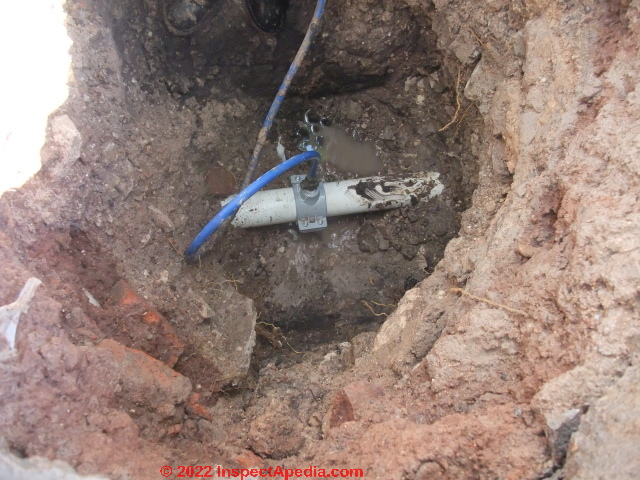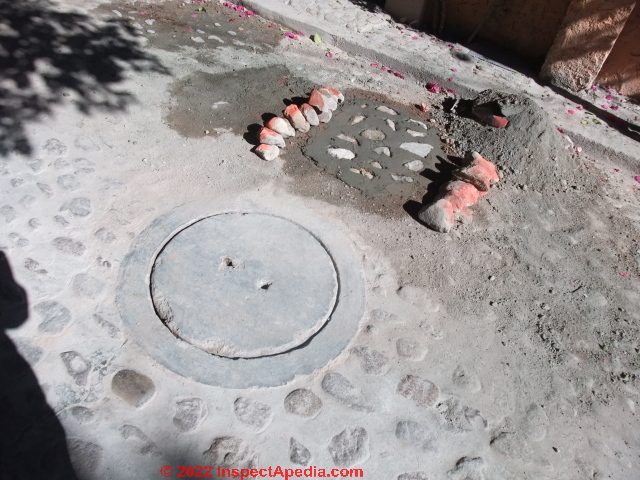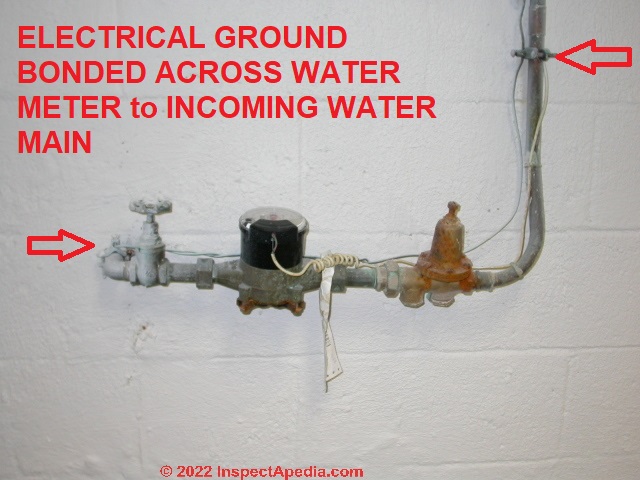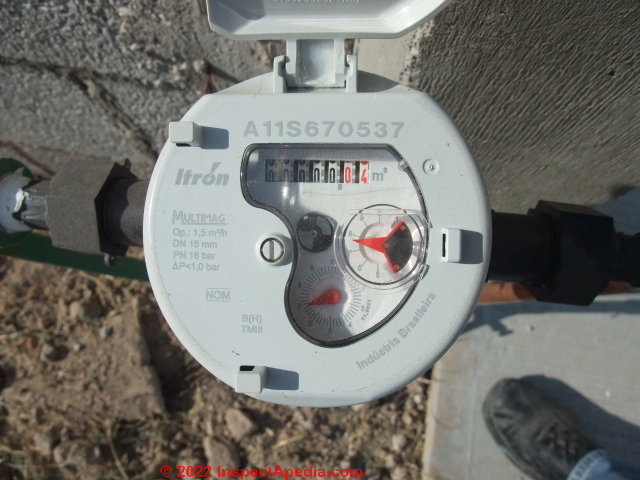 Residential Water Meters
Residential Water Meters
Water meter reading, types, uses, readout, troubleshooting
- POST a QUESTION or COMMENT about this article topic.
This article describes water meters found in residential properties served by a community or municipal water source.
We discuss types of water meters, how to find a water meter, how to read a water meter, water meter accuracy, meter reading transmitters, and we include links to further detail about troubleshooting excessive water use, high water bills, water leaks, and water pressure & flow problems.
Page top photo: the water meter, if it is inside the building, is usually located where the entering water line passes through the building's foundation wall and then just on the "house-side" of the main water shutoff.
InspectAPedia tolerates no conflicts of interest. We have no relationship with advertisers, products, or services discussed at this website.
- Daniel Friedman, Publisher/Editor/Author - See WHO ARE WE?
How to Find, Read, Check Your Water Meter

What is a water meter
What does the water meter measure, where are water meters used, and in general, how do water meters work?
[Click to enlarge any image]
Water meters measure the volume of water that passes through a pipe used by residential and commercial building units that are supplied with water by a public water supply system.
Water meters are also used to determine the flow rate through a particular portion of the system.
Photo: water meter and a lead water entry main in a New York home. [Click to enlarge any image]
Water meters are generally owned, read and maintained by a public water provider such as a city, rural water association or private water company.
The information they receive from your water meter generates the amount of your water bill. It's also a good idea to be able to read your own water meter, since it will help you understand your water bill better, help you manage your water usage, and give you an indicator of unintended water usage such as a leak somewhere.
Most meters in a typical water distribution system are designed to measure cold potable water only.
The means by which a water meter measures the volume of water varies based on what type of flow measurement is used. The two most common mechanical approaches are displacement and velocity. Non-mechanical designs include electromagnetic and ultrasonic measurement methods.
Types of water meters
There are two conventional measuring devices for water flow measurement, the positive displacement water meter, and the velocity meter. Other meter types are available however.
Positive Displacement (PD) meters
 Displacement water meters, often called Positive Displacement (PD) meters, are the most common water meters for residential and small commercial properties.
Displacement water meters, often called Positive Displacement (PD) meters, are the most common water meters for residential and small commercial properties.
PD meters rely on the water to physically displace the moving measuring element in direct proportion to the amount of water that passes through the meter. This photo is of a Badger water meter installed in a home in Two Harbors, MN.
Velocity meters
A velocity-type meter measures the velocity of flow through a meter of known internal capacity. The speed of the flow can then be converted into a volume of flow to determine the usage. There are a number of types of velocity meters including Multi-jet, Turbine, and Compound meters.
Electromagnetic meters
Magnetic flow meters, commonly referred to as "mag meters", are technically a velocity-type water meter, except that they use electromagnetic properties to determine the water flow velocity, rather than the mechanical means used by jet and turbine meters.
Ultrasonic meters
Ultrasonic water meters use one or more ultrasonic transducer to send ultrasonic sound waves through the fluid to determine the velocity of the water.
Prepaid water meters
Meters can be prepaid or postpaid, depending on the payment method. Most mechanical type water meters are of the postpaid type, as are electromagnetic and ultrasonic meters. With prepaid water meters, the user purchases and prepays for a given amount of water from a vending station.
[text in process]
How to find your water meter
It is important to know where to find the water meter for your building, and even more important, know how to find the building's main water shutoff.
At the top of this page we mentioned that the water meter, if it's inside the building, is usually located quite close to the building's foundation wall where the water line enters the building.
Here are tips for finding the water meter at your home or building.
- Is there a water meter at all? If your building is served by a private well and pump system or by some other private water supply source such as a spring, you probably don't have a water meter.
- Is your building in a cold or freezing-climate? If so then the water meter will usually be indoors - in order to protect it from freeze-damage.
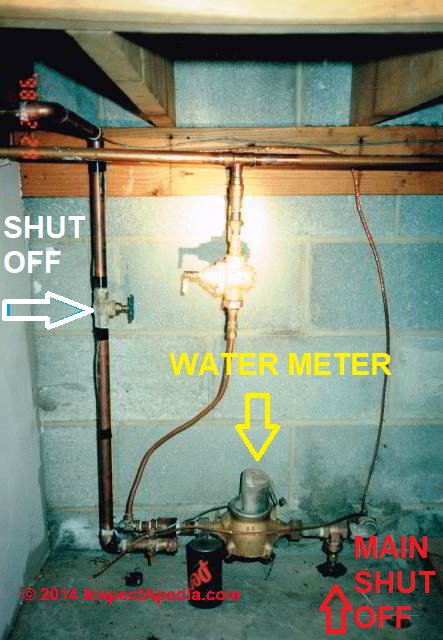
Above: in cold climates, the water meter is usually located in a freeze-resistant location such as in a basement or mechanical room, and will normally be found where the incoming water main enters the building. The main water shutoff should be found just ahead of the water meter, on the "street" side, and often a second shut-off will be found on the building side of the meter.
If you live in a hot or warm climate your water meter might still be indoors,
or it might be outside mounted on a building wall where the water line arrives at your building,

Above: a group or "gang" of water meters outside of a multi-family residence in Guanajuato, Mexico.

or the water meter might be in a small service pit in the ground, protected by an access cover. (photos above and below)
Above: in warm climates such as Arizona, the building's water meter may be located in an access well near the street.
- Does your building have a basement ? If so inspect the basement walls to look for either a water meter or a hatch or panel opening that can be opened to disclose the water meter.
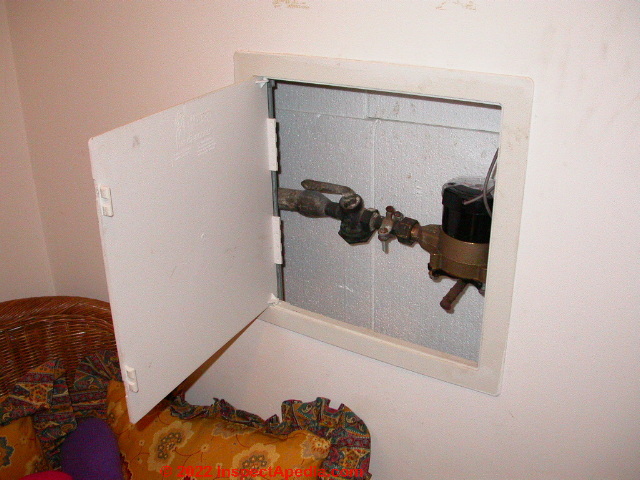
Above: in a finished basement of a northern home, the water meter may be found behind an access panel where the water main enters the building.
If your building is on a crawl space, only a dope would put the water meter there where it's the devil to access.
If your buliding is built on a concrete slab, look for the water meter where the water main enters your building - on a wall or in a slab-access pit. - Follow the water pipes: in your building's basement, crawl space, or slab-on-grade utility areas, find any cold water supply pipe and follow it back to find where the water main enters the building. There you should find a main water shut-off and the water meter and perhaps a water pressure regulator.
- Find the municipal water main: check with your neighbours or with your local water supply company to ask where their water main is located. Often, but not always, the community water main is located in the street in front of your property.
When you know from which side the municipal water main approaches your building, it's a reasonable guess that the water line between the water main and your building approaches your building from that direction. So you'll know which basement wall, crawl space side, or slab side your water line, shutoff, and water meter should be found.
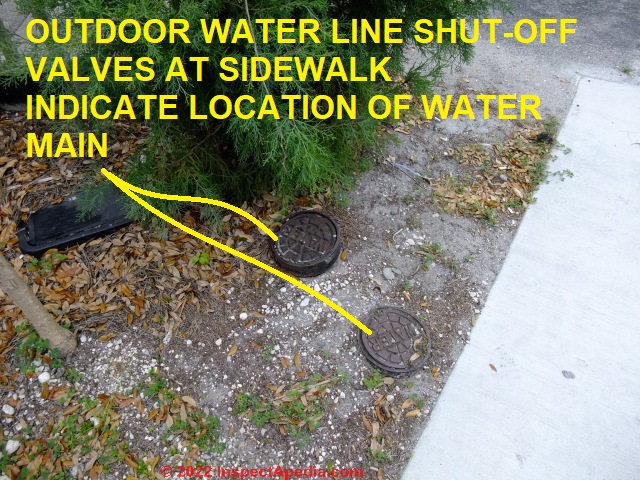
Above: found adjacent to the sidewalk in front of a Delray Beach Florida home, the two small round cast-iron covers are labeled "WATER" and are a good clue to the location of the water main. From these we can guess at which side of the home we should find the water meter.
How to Read a Water Meter
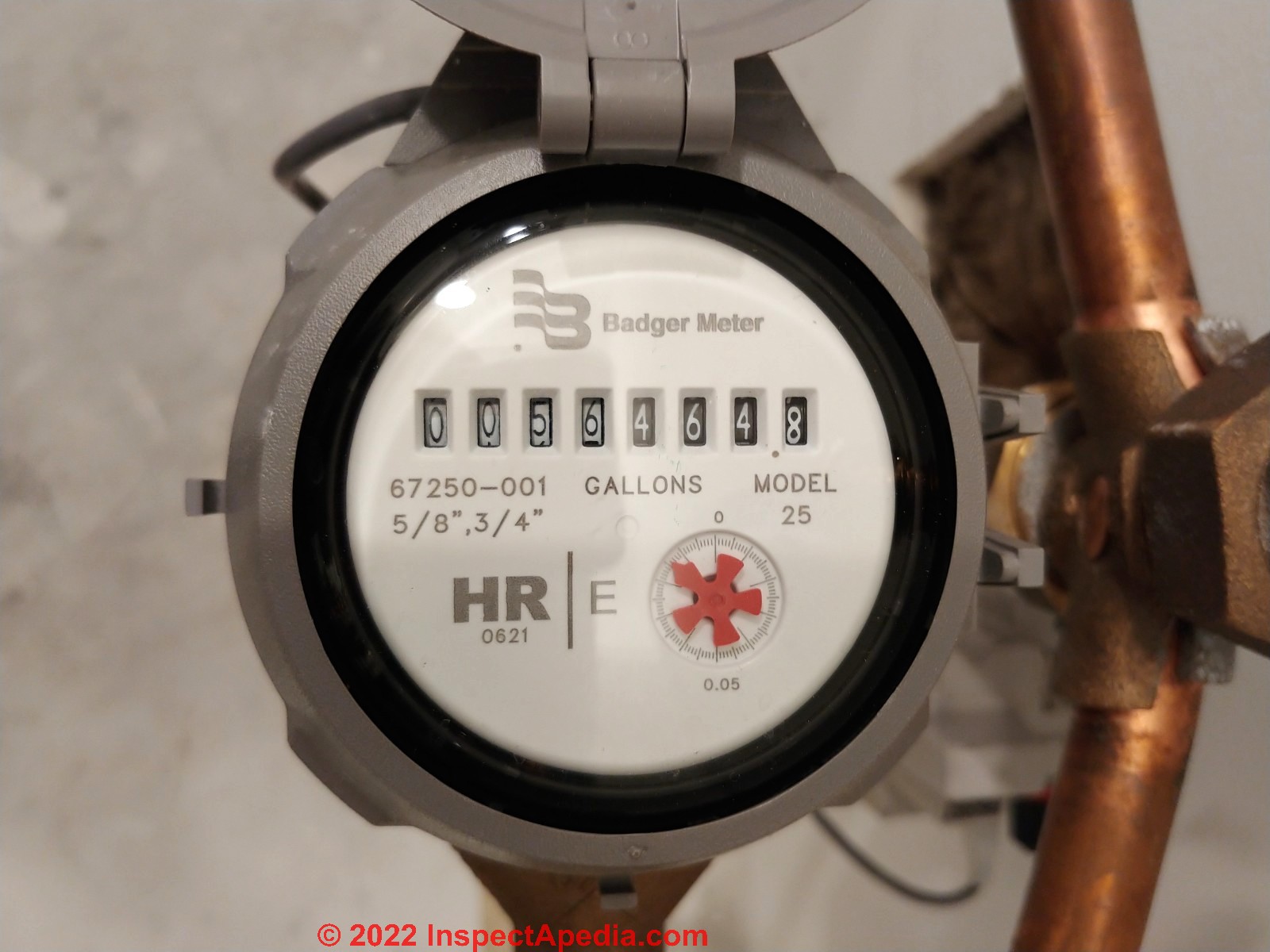 Water meter readings are usually in cubic feet, or in cubic meters.
Water meter readings are usually in cubic feet, or in cubic meters.
Some homeowners are interested in understanding their total or periodic water usage in gallons, and water flow rates in gallons per minute (gpm), or gallons per hour (gph), etc.
Here we'll describe how to read a water meter and how to convert among these measures.
Analog registers are normally driven by a magnetic coupling between a magnet in the measuring chamber attached to the measuring element and another attached to the bottom of the register.
Gears in the register convert the motion of the measuring element to the proper usage increment for display on the sweep hand and the odometer-style wheels.
In the United States, most utilities bill only to the nearest 100 or 1,000 gallons (10 to 100 ft.3, 1 to 10 m3), and often only read the leftmost 4 or 5 numbers on the display wheels. The most common rounding for a particular size meter is often indicated by differently coloured number wheels, the ones ignored being black, and the ones used for billing being white.
Photo: a Badger water meter, installed in a home in Two Harbors, Minnesota, shows the white and black numerals described here, with a final decimal point instead of a sweep hand.
The faces of various water meters will show the usage and flow differently. Some will have a large sweep hand that rotates around the dial, measuring water usage in gallons or cubic feet.
A complete sweep would equal 10 gallons or 10 cubic feet, depending on the type of unit measurement. The number indicated by the sweep hand would replace the last static 0 in the row of numbers.
Other meters will have just the row of numbers that change with water usage. Instead of a sweep hand marking the use of 1-10 gallons, the last number in the dial, after the decimal point, will record that increment of usage.
Digital meter displays alternate between the water usage reading and the flow rate and require exposure to light to be read.
Water Meter Reading Conversions
- Convert cubic feet to U.S. gallons: 1 cubic foot = 7.48 U.S. gallons.
- Convert cubic feet to Imperial gallons: 1 cubic foot 6.23 Imperial gallons
- Convert cubic meters to liters: 1 cubic meter = 1000 liters
- Convert cubic meters to U.S. gallons: 1 cubic meter = 264.17 U.S. gallons
- Convert cubic meters to Imperial gallons: 1 cubic meter = 219.97 Imperial gallons
- Water flow rates: are explained along with suggested measurement methods separately
at WATER FLOW RATE CALCULATE or MEASURE - how much water is delivered at a plumbing fixture
See also WATER PRESSURE MEASUREMENT - how to measure water pressure & flow in a building
Water Meter Accuracy & Water System Leak Detection
Although most types of water meters measure water usage quite accurately, some are in fact more-accurate than others. These include:
- Positive Displacement
- Multi-jet (velocity type)
- Ultrasonic
Still accurate but less so if certain conditions are present:
- Turbine (velocity type)
- Electromagnetic
There are occasions where you may question the accuracy of your water meter. Perhaps your bill from one month is markedly higher than the previous month without an obvious reason, yet the diagnosis and repair of the cause is not always clear.
The most common cause of increased water usage is a continuous water leak somewhere in your water supply system. It could be obvious such as a dripping faucet or a constantly running toilet or less visible such as an underground leak in the water piping from the water main to your house.
But a water supply system leak can also occur outside the building: on the house side of the water meter in some cases or even on the street side of the meter - where the leak won't register.
Above: wet areas in the street and a sound of running water led to discovery of a leak outside of the home whose blue PEX incoming water line can be seen connected to the white water main.
A close look at the gray plastic clamp fitting showed a stress fracture that was the cause of the leakage - below.
And below, the cobblestone street has been repaired after the broken clamp was replaced, stopping this leak. These repairs were made by the water utility company, not the homeowner, as the damage was in their components and outside the home.
In a separate water meter accuracy question and leak case, before returning to his home after a long absence, a homeowner received a water bill enormously greater than ever before - though the home had been virtually empty!
Knowing the home was well maintained and water conservation measures in place, he assumed that the fault had to be with the municipal water meter itself and requested its replacement, which the municipality did.
Really? Upon his return however, in looking through the house, he found obvious and excessive mineral deposit build-up at one toilet signifying that the toilet had been running continuously for months.
Another example could be an underground leak in a water pipe that would be silent and almost invisible, unless the ground appeared wet or nearby plants were growing better than ever. As noted above, in Arizona and other warmer climes, the water meter is often found near the street in a covered access pit in the ground.
If there were a leak in the water pipe leading from the street to the home, the water meter would accurately report increased water usage due to this leak even if undetected by homeowner.
It's possible that the water meter itself is defective and therefore giving inaccurate readings of water usage.
What to Check if You Suspect Your Water Meter is Inaccurate
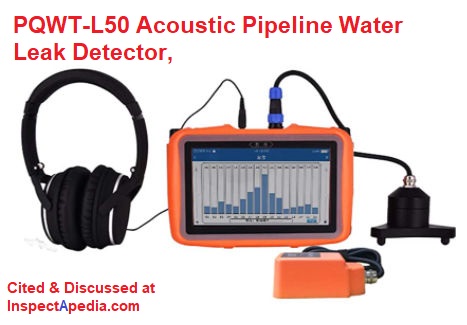 If you think that your water meter is showing much more water use than you expect, here are some things to check.
If you think that your water meter is showing much more water use than you expect, here are some things to check.
Illustration above: the PQWT-L50 Acoustic Pipeline Water Leak Detector, Smart Home Use Plumber Leak Detector, an acoustic water leak detector produced by Hunan Puqi Geologic Exploration Equipment Institute and sold by plumbing suppliers and online suppliers as well.
- Check first for a visible or easily found water leak
anywhere in your plumbing system on the house side of the water meter.
Don't forget to look for less obvious leaks such as a running toilet or a leak in under slab or underground piping. Acoustic tools used by some plumbers as leak detectors can tell if water is running in a pipe. - Turn off water:
If there is a second water shut-off on the house side of your water meter, turn that off and confirm that the water meter isn't continuing to run. - Measure water usage:
When you've learned how to read your water meter accurately, you can turn off all fixtures except one, run a measured volume of water there, and compare that to your water meter's indication.
- Look for wet spots or subsidence outdoors
in your property along the route followed by your incoming water pipe between the water main and the location of your main building water shutoff valve. - Listen to your water pipes by ear:
With all water turned off inside your home, listen yourself, at the water meter, on the street side, using your ear or a mechanic's stethoscope: do you hear the whirring sound of water running? - Acoustic leak detection:
Hire a plumber who can offer leak detection using an acoustic leak detection device. Acoustic leak detectors work by having been calibrated to recognize the sound of abnormal water flow through the building plumbing system or to detect any water flow at all if you think your water system is fully shut off. - Ask your water supply company
for leak detection help and for a check of your water meter's performance.
Watch out: So before embarrassing yourself and claiming no fault, be sure to check the possible sources of increased water usage or leaks besides a faulty water meter.
Some resources to help do this are found
at
PLUMBING LEAK DETECTION METHODS
Water Meter Reading Transmitters
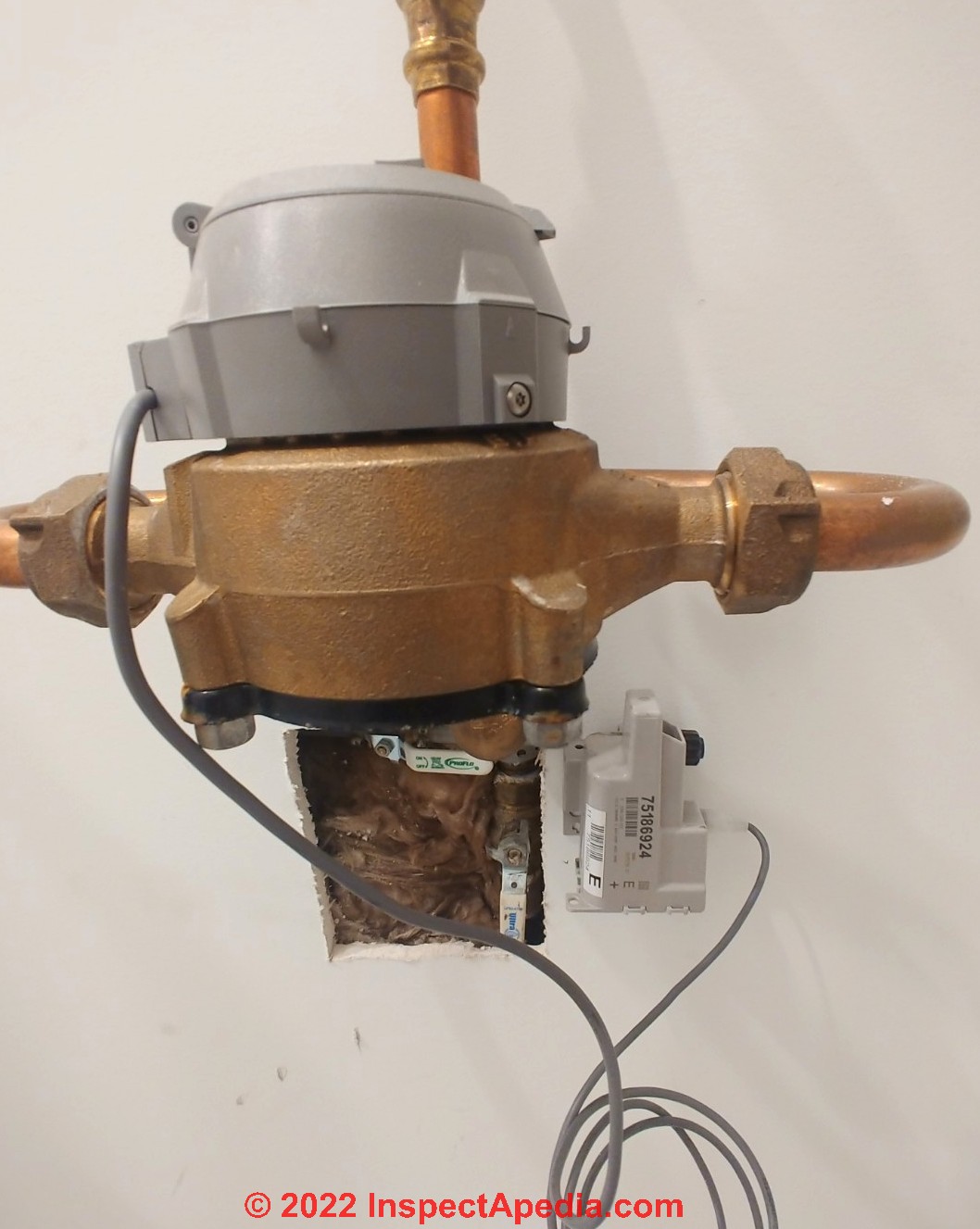 Automatic meter reading (AMR) uses various technologies to collect water usage data from a residential or commercial customer. These can include handheld, mobile and network systems using wireless networks, radio frequencies, or powerline transmissions.
Automatic meter reading (AMR) uses various technologies to collect water usage data from a residential or commercial customer. These can include handheld, mobile and network systems using wireless networks, radio frequencies, or powerline transmissions.
One example of this would be the utlility company employee reading your water meter simply by driving or walking by. There is no need for access to the inside of the home. (Photo to the left is of a water meter reading transmitter in Two Harbors, MN, mounted on the wall, out of harm's way, and attached by a wire to the gray water meter above.)
Despite a few potential disadvantages of AMR, the benefits to both the utility provider and customer are recognized to outweigh the risks.
Some of the benefits include:
- accurate meter reading, no more estimates
- improved billing and tracking of usage
- improved resource management - both in costs of actual meter reading and in billing management
- improved energy management through data graphing
- supply managment
- improved security and tamper detection
Potential disadvantages:
- risk of loss of privacy - usage reveals information about user activities
- increased security risks from network access
- greater potential for unauthorized monitoring
Building Electrical Ground at Water Meter
Watch out: if your building's metal water supply piping is being used as an electrical ground, for safety, the grounding conductor must be bonded to the water piping on both sides of the water meter and thus onwards to the buried incoming water main.
That's because a diaelectric fitting in some water meters can interrupt the continuity of electrical ground if the building's grounding conductor is connected only to water piping on the house-side of the meter.
See details at ELECTRICAL GROUNDING in OLD HOUSES
How to Reduce Water Usage
Advice on reducing water usage is found in the Recommended Articles at the end of this page and includes a wide range of topics from water leaks to low water usage fixtures to simply making a small adjustment in water pressure to reduce un-needed usage rate.
Water Meter Standards, Guides, Sources
- ASTM D5089-95 (2014)
Standard Test Method for Velocity Measurements of Water in Open Channels with Electromagnetic Current Meters
ASTM standards can be purchased at website: astm.org - AWWA WATER METERS - Selection, Installation, Testing, & Maintenance [PDF] (2012) an excerpt section from American Water Works Association Manual M6, retrieved 2022/02/09 original source https://www.awwa.org/portals/0/files/publications/documents/m6lookinside.pdf
- AWWA ADDENDUM to WATER METERS - Selection, Installation, Testing, & Maintenance [PDF] (2018) an excerpt addendum section from American Water Works Association Manual M6, retrieved 2022/02/09 original source https://www.awwa.org/Portals/0/files/publications/documents/erratum-addendum/Addendum%20to%20M6.pdf
- BS EN ISO 4064-2 - TC - Tracked Changes (Redline) - Water meters for cold potable water and hot water Part 2: Test methods February 26, 2020 - BSI This part of ISO 4064|OIML R 49 is applicable to the type evaluation and initial verification testing of water meters for cold potable water and hot water as defined in ISO 4064-1:2014|OIML R 49-1:2013.
- ISO 4064-1:2005(en)
Measurement of water flow in fully charged closed conduits — Meters for cold potable water and hot water - https://www.iso.org/obp/ui/#iso:std:iso:4064:-1:ed-3:v1:en
Excerpt of Scope:
This part of ISO 4064 specifies terminology, technical characteristics, metrological characteristics and pressure loss requirements for cold potable water and hot water meters.
It applies to water meters that can withstand maximum admissible working pressures (MAP) = 1 MPa1) (0,6 MPa for meters for use with pipe nominal diameters, DN = 500 mm) and a maximum admissible temperature, MAT, for cold potable water meters of 30 ºC and for hot water meters up to 180 ºC, depending on class.
This part of ISO 4064 also applies to water meters, based on electrical or electronic principles and to water meters based on mechanical principles incorporating electronic devices, used to meter the actual volume flow of cold potable water and hot water.
It also applies to electronic ancillary devices. Generally ancillary devices are optional.
The specifications of this part of ISO 4064 apply to water meters, irrespective of technology, defined as integrating measuring instruments continuously determining the volume of water flowing through them.
Above: a Badger water meter and Itron meter reading transmitter in the cold climate of Two Harbors, Minnesota, and below, another Itron water meter located outdoors in a warm climate, at a home in Los Mesquites, San Miguel de Allende, Mexico.
- Itron Headquarters
2111 N Molter Road
Liberty Lake, WA 99019
Sales: 866.374.8766
Support: 877.487.6602 or 509.891.3005
Office: 509.924.9900 or 800.635.5461 Web: https://www.itron.com/
Corporate fact sheet excerpt:
Itron enables utilities and cities to safely, securely and reliably deliver critical infrastructure solutions to communities in more than 100 countries. Our portfolio of smart networks, software, services, meters and sensors helps our customers better manage electricity, gas and water resources for the people they serve.
Editor's note: 2022/02/04 We sent a request for product specification and technical review of this article to Itron and will report the company's advice here. To date the company provided generic marketing literature but no technical comment.
- Gopan C K*, Jacob Chandapillai, U Muthukumar STANDARDS on WATER METERS [PDF] (2018)
Conference: IWWA Annual Convension 2018 At: Panaji, Goa Project: Water Meter Testing
Abstract:
Selection and testing of water meters are performed based on Indian and international standards like IS 779, IS 2373, ISO 4064 and OIML R 49. Recently the international standards have been revised by including different types of meters. More flexibility in specification is given to incorporate water meters based on various working principles as well as operating conditions.
These additions are not adopted in the Indian standards. In this situation how to frame a suitable specification for Indian scenario to get good quality meters for minimum price is discussed in this paper. The importance of meter testing and standard quality assurance practices are also discussed in detail. Keywords: Water meter, testing, quality assurance, sampling, certification . - India, GUIDELINES on WATER METERS [PDF] (2015) Government of India, Works Directorate dk;Z funs”kky; Research Design and Standards Organization, Lucknow
- US DOE, TECHNICAL WATER METER SELECTION GUIDELINES [PDF] U.S. Department of Energy, retrieved 2022/02/03 original source: https://www.energy.gov/eere/femp/technical-water-meter-selection-guidelines
- WUM, HOW TO READ A WATER METER [PDF] Water Utility Management, LLC.
28 Abercorn Street
Savannah, Georgia 31401
(912) 352-9339
(888) 352-9339 (toll-free)
CustomerCare@waterga.com - retrieved 2022/02/03 original source: https://waterga.com/how-to-read-a-water-meter/
Includes tips on leak testing your water system.
Excerpt:
A water meter measures the quantity (volume) of water that passes through a pipe or other outlet. Typically, meters use a standard unit of measure for volume, such as cubic feet or gallons. Your meter works like a car odometer, recording the cumulative amount of water that has passed through the meter.
WUM records every reading, and subtracts the old reading from the new reading to determine the amount of water used since the previous read. By understanding how to read your meter and calculate your usage, you will be able to verify that we are reading your meter fairly and accurately, and to spot problems, such as leaks. - See additional Citations at the end of this page.
...
Continue reading at WATER SHUTOFF VALVE LOCATION, or select a topic from the closely-related articles below, or see the complete ARTICLE INDEX.
Or see these
Recommended Articles
- CHECK VALVES, WATER SUPPLY, DRAINS, PUMPS
- EMERGENCY WATER SHUTOFF VALVE - how to stop water flowing in water pipes to permit emergency or other repair.
- LEAK TYPES, WATER SUPPLY or DRAIN PIPES
- MUNICIPAL WATER PRESSURE DIAGNOSIS
- PLUMBING CONTROLS & VALVES - home
- WATER CONSERVATION MEASURES - home
- WATER FLOW RATE CALCULATE or MEASURE - measurement / calculation of water usage, flow rates, water metering, methods of controlling water usage thorugh metering and flow controls
- WATER PRESSURE REGULATOR ADJUSTMENT
- WATER PRESSURE REDUCER / REGULATOR
- WATER PRESSURE MEASUREMENT
- WATER USAGE REQUIREMENTS provides a table of daily residential water usage.
- WATER SHUTOFF VALVE LOCATION
Suggested citation for this web page
WATER METERS, RESIDENTIAL at InspectApedia.com - online encyclopedia of building & environmental inspection, testing, diagnosis, repair, & problem prevention advice.
Or see this
INDEX to RELATED ARTICLES: ARTICLE I NDEX to PLUMBING SYSTEMS
Or use the SEARCH BOX found below to Ask a Question or Search InspectApedia
Or see this
INDEX to RELATED ARTICLES: ARTICLE INDEX to WATER SUPPLY, PUMPS TANKS WELLS
Or use the SEARCH BOX found below to Ask a Question or Search InspectApedia
Ask a Question or Search InspectApedia
Try the search box just below, or if you prefer, post a question or comment in the Comments box below and we will respond promptly.
Search the InspectApedia website
Note: appearance of your Comment below may be delayed: if your comment contains an image, photograph, web link, or text that looks to the software as if it might be a web link, your posting will appear after it has been approved by a moderator. Apologies for the delay.
Only one image can be added per comment but you can post as many comments, and therefore images, as you like.
You will not receive a notification when a response to your question has been posted.
Please bookmark this page to make it easy for you to check back for our response.
IF above you see "Comment Form is loading comments..." then COMMENT BOX - countable.ca / bawkbox.com IS NOT WORKING.
In any case you are welcome to send an email directly to us at InspectApedia.com at editor@inspectApedia.com
We'll reply to you directly. Please help us help you by noting, in your email, the URL of the InspectApedia page where you wanted to comment.
Citations & References
In addition to any citations in the article above, a full list is available on request.
- Wikipedia, "Water Metering", retrieved 2022/02/06 original source: https://en.wikipedia.org/wiki/Water_metering#Water_meter_reading
- In addition to citations & references found in this article, see the research citations given at the end of the related articles found at our suggested
CONTINUE READING or RECOMMENDED ARTICLES.
- Carson, Dunlop & Associates Ltd., 120 Carlton Street Suite 407, Toronto ON M5A 4K2. Tel: (416) 964-9415 1-800-268-7070 Email: info@carsondunlop.com. Alan Carson is a past president of ASHI, the American Society of Home Inspectors.
Thanks to Alan Carson and Bob Dunlop, for permission for InspectAPedia to use text excerpts from The HOME REFERENCE BOOK - the Encyclopedia of Homes and to use illustrations from The ILLUSTRATED HOME .
Carson Dunlop Associates provides extensive home inspection education and report writing material. In gratitude we provide links to tsome Carson Dunlop Associates products and services.



